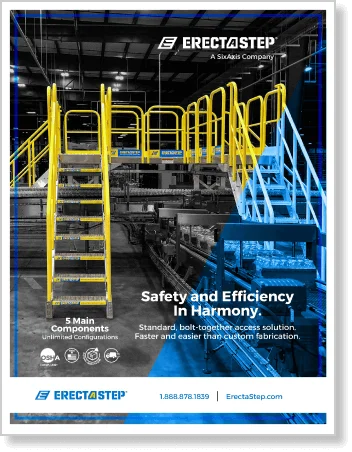In industrial environments, maximizing space is a great way to enhance operational efficiency and worker safety. Mezzanine floors offer a cost-effective solution to expand usable space without extending the building’s footprint. However, the true utility of mezzanines is fully realized only when they pair with safe and reliable access—mezzanine stairs.
ErectaStep specializes in modular, OSHA, and IBC-compliant mezzanine stairs designed to integrate seamlessly with mezzanine floors in various industrial settings. These stairs ensure safe access to elevated platforms and can contribute significantly to your facility’s overall functionality and efficiency.
Key Points You’ll Learn:
- How modular mezzanine stairs can optimize industrial space and improve efficiency.
- The importance of OSHA-compliant mezzanine stairs for safety in industrial settings.
- The types of mezzanine stairs best suited for different applications.
- Benefits of quick, easy installation and customization options for your facility.
The Importance of Mezzanine Stairs in Industrial Settings
Mezzanine stairs are more than just a means of access; they are a critical component of industrial space optimization. In environments such as warehouses, manufacturing plants, and distribution centers, the ability to safely and efficiently access different levels can drastically improve workflow and productivity.
Whether accessing elevated storage areas, machinery, or office spaces, mezzanine stairs must be designed to meet safety standards appropriate for your industry while also adapting to your facility’s needs. Mezzanine stair systems should be engineered to provide the perfect balance of safety, durability, and ease of installation.
Types of Mezzanine Stairs
Choosing the right type of mezzanine stairs depends on your specific application and space constraints. Here are the primary types of mezzanine stairs:
- Standard Stairs: These stairs are ideal for general access in larger mezzanine areas. They are designed for easy navigation and can handle frequent use in high-traffic environments.
- Alternating Tread Stairs: Perfect for tight spaces where a smaller footprint is necessary. These stairs provide a space-efficient solution without compromising on safety.
- Ship Ladders: A great solution for mezzanines with limited space, ship ladders offer a compact, steep design that maximizes floor area efficiency while maintaining safe access. They are best for applications with less frequent use, ensuring safe and efficient access to mezzanines or elevated platforms.
- Custom Stairs: Tailored solutions for unique industrial needs, such as accessing complex machinery or navigating around existing structures. Custom mezzanine stairs can be designed with specific dimensions, materials, and features to meet your facility’s requirements.
Material Considerations for Mezzanine Stairs
The choice of materials for mezzanine stairs impacts both their durability and performance. Consider these materials that suit a variety of industrial needs:
- Aluminum: Lightweight, corrosion-resistant, and easy to maintain. Aluminum mezzanine stairs are ideal for both indoor and outdoor environments and offer a long service life without the risk of rusting.
- Steel: For applications requiring extra strength and load-bearing capacity, steel is the material of choice. Steel mezzanine stairs are often used in heavy-duty industrial settings where durability is paramount.
- Stainless Steel: Offers the same strength as regular steel but with added corrosion resistance, making it suitable for environments exposed to moisture, chemicals, or extreme temperatures.
Compliance and Safety Standards
When choosing mezzanine stairs, safety and compliance should be top priorities in the design process. Our mezzanine stair systems are pre-engineered to meet or exceed OSHA and IBC safety standards, ensuring your facility remains safe and compliant with all relevant industry regulations.
- OSHA Compliance: Our stairs are designed to meet OSHA standards for tread depth, riser height, and handrail specifications. This compliance is crucial for reducing the risk of workplace injuries and ensuring a safe environment for employees.
- IBC Compliance: For applications that require adherence to the International Building Code (IBC), we offer fully compliant mezzanine stairs, including considerations for fire safety, load-bearing capacity, and egress requirements.
Customizing Mezzanine Stairs for Specific Applications
Modular mezzanine stair systems can be customized to meet the unique needs of your facility. Whether you require additional safety features, specific dimensions, or a particular aesthetic, our modular design allows easy customization and reconfiguration.

For example, if your facility’s layout changes over time, modular stairs can be easily disassembled and reassembled in a new configuration, saving time and money.
Installation and Maintenance
One key advantage of modular mezzanine stairs is their ease of installation. Our prefabricated, bolt-together components eliminate the need for welding or custom fabrication, allowing for quick and straightforward assembly.
- Installation Tips: Before installation, assess the structural integrity of your existing mezzanine and ensure that the stair placement complies with all safety regulations. ErectaStep’s configurator tool can help you visualize your project and ensure the design meets all OSHA requirements.
- Maintenance Tips: Regular inspections and maintenance are essential for ensuring mezzanine stairs’ long-term safety and functionality. Check for wear and tear, especially in high-traffic areas, and keep the stairs clean and debris-free to prevent accidents.
Why Choose ErectaStep for Mezzanine Stairs
ErectaStep’s mezzanine stair systems offer unparalleled benefits in terms of safety, durability, and customization:
- Modular and Customizable: Our stairs can be tailored to fit any industrial application, with modular components allowing easy reconfiguration.
- Compliance: Every stair system is pre-engineered to meet OSHA and IBC standards, eliminating the need for costly and time-consuming custom engineering.
- Durability: Made from high-quality materials like aluminum and steel, our stairs are designed to withstand the toughest industrial environments.
- Ease of Installation: Prefabricated and ready to ship, ErectaStep stairs can be installed quickly and with minimal disruption to your operations.
Conclusion
Mezzanine stairs can be an important component of any industrial space, providing safe and efficient access to elevated areas while optimizing your facility’s layout. ErectaStep’s modular, OSHA-compliant stair systems are designed to meet the unique needs of industrial environments, offering a perfect blend of safety, durability, and flexibility.
Optimize your industrial space with ErectaStep’s OSHA and IBC-compliant mezzanine stairs. Contact an ErectaStep Representative to learn how our customizable solutions can enhance your facility.
